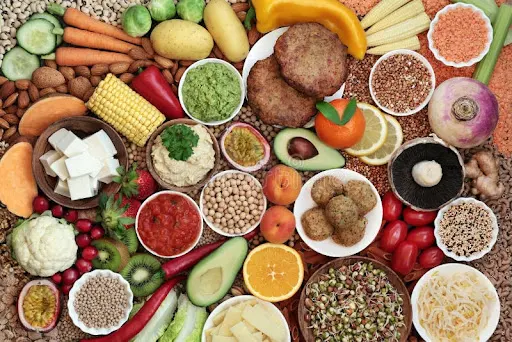India: it's varied food culture :
1.Rice : Staple diet of many regions.
Amazing fact :People are not obese in these areas because of rice consumption, so ???
India is a vast country but united with one staple food , that is rice. About 40,000 varieties of rice are available.
The types of rice consumed in India are White rice , Brown rice, Red rice, Black rice , Sticky rice , Parboiled rice , Basmati rice , Jasmine rice , etc.
Most of the Indian states are rice eating states . There are 29 states in India which have different cultures of their own but all of them share their love for food with Biryani , Pulao , Khichri , Pongal , Bisi bele bath , Kedgeree , Bamboo rice , Chambray, Mizo bai , Pakhala Bhata , and many more rice dishes. Apart from eating rice for lunch and dinner, Indians have delicacies made from rice flour , rice flakes , rice puffs , rice milk , rice paste so rice is consumed in any part of the day as snacks , desserts, main course , appetizers .
Apart from being a food, rice is auspicious . Rice grain is used in marriage. It is applied on the forehead with vermilion. It is fed to pregnant ladies as rice pudding for a healthy child. It is the first food for a child when it starts weaning. It is a holy food offered to Gods .
There are records of rice production in India in 1000 BC. Rice is either Hand pounded or Machine milled or Parboiled followed by hand pounding or machine milling.
Hand pounding is done by the farmers who cultivate rice for their own consumption. It does not remove the bran completely so vitamins are better preserved.
Most of the rice available in the market is machine milled. This type of rice is less likely to be contaminated by insects which destroy stored grains ;easily digested and absorbed; looks clean and attractive; contains little phytate and hence minerals from other foods are better absorbed. But variable proportions of vitamin B complex , calcium, iron, proteins and fats are removed.
In some states like Tamil Nadu , Bengal , Goa , etc Parboiled rice is consumed. Parboiling is a process in which the paddy is soaked in water and the water is boiled , the water is drained and the paddy is dried before milling. The grain is harder after Parboiling; it can be preserved both in cooked and uncooked states ; the nutrients are well preserved.
Is Rice the cause of weight gain?
It depends upon how it is consumed . Many rice eating areas have started eating wheat after the myth that rice is the main reason for weight gain and diabetes. But really are they cured of these problems? I have seen those people suffering from heartburns , acidity , etc because they haven't eaten wheat flour earlier and now at the age of 60s they are forced to eat wheat products.
Rice has its own benefits.
They are
😊 Rice provides about 350 kcal per 100 gms , wheat also provides 350 kcal per 100 gms .
😊Rice contains about 7% protein but is deficient in amino acid Lysine so always consume rice with soya bean or pulses or fish or curd or milk to balance the diet.
😊Rice is easily digested.
😊If eaten with pulses , it provides bulk so the feeling of hunger is reduced.
😊Smaller feeds of rice with milk or milk products are easily digested even during acute illness.
😊Free of gluten , good choice for people with allergies.
😊Remedy for diarrhoea and heartburn
😊Folate lowers the risk of birth defects and heart disease.
😊Magnesium improves PMS and kidney stones.
😊Oryzanol relieves menopausal hot flashes, lower cholesterol levels and prevents the harmful conversion of nitrogen compounds into cancer causing nitrosamines. It is found in the bran layer.
😊Selenium prevents allergies, asthma, cataracts, infertility and prostate problems.
😊Vitamin B6 helps to thwart allergies, anxiety, asthma, depression and heart disease.
😊Fermented rice products like idli , dosa , appam ,dhokla , ambali , kanji or fermented rice increase the nutritive value . It facilitates enzyme action during digestion .
Maximise the benefits
♥️When cooking rice , do not rinse it before or after because it washes away the essential nutrients.
♥️Avoid cooking with excess water to retain B vitamins.
If you think that if you drain the rice water , it becomes less starchy, less calorie, then please don't do it, rice is dense in starch so you are not taking out the starch but losing upto 33%of vitamins
♥️MIND THE QUANTITY OF RICE YOU ARE EATING. YOU CAN'T COUNT RICE LIKE BREAD SO YOU EAT TILL YOU ARE FULL. ALWAYS MEASURE THE QUANTITY OF RICE AND CURB YOUR HUNGER WITH VEGETABLES AND PULSES AND SALADS AND FRUITS. IT'S A WISE OPTION TO EAT RICE IN A SMALLER PLATE .
♥️Do not combine rice with potatoes ,tapioca or high starch fruits and vegetables. Instead combine it with pulses, fish , chicken and fruits and vegetables.

.jpeg)








.jpg)


.jpg)